|
1 INTRODUCTION
Both maintenance, having a technical factor, and management, having social and economical factors,
including the budget to apply it, are necessary for the long-term safety of social infrastructures. Considering
the maintenance, the deterioration mechanism in the structure has been analyzed, and various methods
for repair and strengthening, such as ISO 16311 and some Japanese guidelines, have been proposed. On
the other hand, considering the management, the life cycle cost (LCC) for one structure has been investigated.
However, there is little research on the maintenance and management of several structures.
In particular, management aiming at reasonable maintenance is important, especially in Japan, when
the performance of the structure is evaluated over time, the tax revenue decreases, and an previously
built structures become obsolete.
As a result, a subcommittee on “priority in maintenance and management of deteriorated concrete
structures (JSCE-342)” was organized from May 2010 to December 2015. The committee consisted
of three task forces. The first working group calculated the structural performance of the deteriorated
reinforced concrete. There are two types of analytical models, including a rough model that uses
some input data based on easy inspection techniques, and a detail model that uses several input data based
on the high-level inspection system. In addition, the maintenance procedure for prestressed concrete (PC)
structures was investigated. The second working group summarized the non-destructive test methods,
which obtained the physical properties of concrete and steel bars. In addition, these results looked at the
input data for the models designed in the first working group. The third working group simulated the
case studies. Based on three types of deteriorated speeds, the time-dependent performance of selected
concrete bridges was considered using the models and systems designed by the previous two working
group activities, and the LCCs were calculated. Moreover, in the simulated scenarios, the structures
were repaired by preemptive or corrective maintenance.
This article introduces a part of the final report, which was published in November, 2015. In Section
2, examples of the case study promoted under the flow of ideal maintenance (shown in Figure 1) are
introduced. In Section 3, a method to investigate the substitution value of the performance evaluation
model for the deteriorated member on-site is analyzed. In Section 4, modeling techniques for evaluating
the structural performance of deteriorated members is analyzed, while differentiating tbem from the
model used for the design of a healthy member.
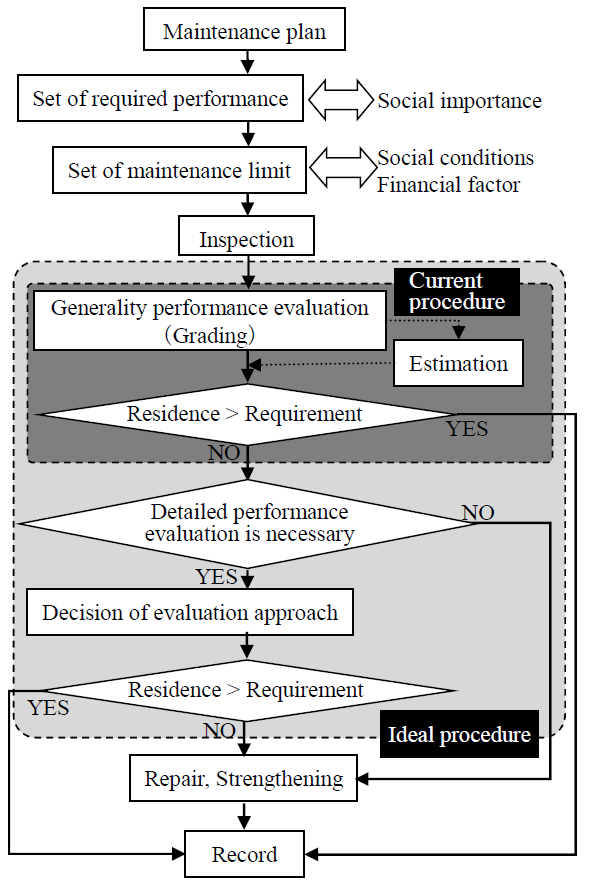
Figure 1. Flow of ideal maintenance.
2 CASE STUDY PROMOTED UNDER IDEAL MAINTENANCE FLOW
When the maintenance priority is determined only by considering social factors, such as the importance of
the structure or budget, the risk of accidents, such as the bridge collapse, increases because the deterioration
degree and soundness are ignored. Therefore, the maintenance priority should be decided while
considering the engineering data on the state of the structure. However, practically, maintenance is promoted
in accordance with evaluation based on the standard grade. This is effective for structures which
share a similar design and structure type, and are exposed to similar environment actions. However,
many local governments and administrators maintain structures, the deterioration of which progresses individually.
As a result, countermeasures for achieving safety may be taken excessively. Therefore, it is
anticipated that performance-based maintenance may eliminate unnecessary repair and strengthening in the
future, as shown in the ideal flow in Figure 1. In this section, a case study on the maintenance of a target structure, including the structural analysis, is explained.
The target structure was built using concrete with a water cement ratio of 65%, and the distance from
sea was set at three levels of ~400 m, ~100 m, and ~10 m. The deterioration progress is shown in Table
1. Two types of maintenance limits were also set based on the social importance, including a case
where concrete did not exfoliate due to expansion under steel corrosion, and another case where the ultimate
load performance satisfied a required value. Furthermore, the costs of construction, inspection,
and repair were used based on the standard value of in 2014.
Table 1. Deteriorated situation and its year.
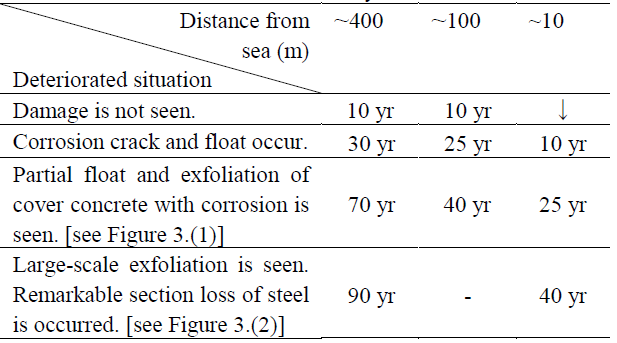
Trial calculations were carried out for 34 cases. It was confirmed that corrective maintenance was effective
because the risk of exfoliation decreased when the deterioration progress was fast. In addition,
in the case of preemptive maintenance, when current patch repair was carried out without removing the
concrete in which chloride was included in sufficient quantity, re-deterioration and re-repair were repeated.
Consequently, the maintenance cost increased to 10 times the construction costs, and the LCC was
remarkably higher. Therefore, it was thought that it was extremely important to carry out the repair so
that the re-deterioration did not occur once the state of the structure was grasped by the chloride content.
In this case, the ratio of cost of the detailed investigation among the entire LCC was even smaller. In
addition, the development of the new repair method would be effective for prolonging the service life.
3 PARADIGM OF NONDESTRUCTIVE TEST FOR ADVANCEMENT OF MAINTENANCE
The result derived from the grading evaluation may have an excessive safety factor. Therefore, nowadays,
when the number of aged structures increases, the number of targets that require repair may also increase,
and a lack of workers, cost, and time to repair are matters of concern. Thus, it is unfavorable to encourage
the grading method for evaluation of the structural performance in order to avoid excessive repair work in future.
The problem to provide the information of the nondestructive test for necessary input data to the
structural analysis in the structural performance of deteriorated members was also discussed. As a result,
it could be verified that a method for an aged member to convert the information from nondestructive
tests into physical or mechanical properties of materials was different from that for a sound member.
Especially in the case of the deteriorated member, there are insufficient standards for converting
the information obtained using non-destructive tests into physical property values, as shown in Table 2.
In addition, the variation in the reduction in crosssectional area of steel cannot be observed directly
because the rebar is embedded in concrete. The structural capacity of the deteriorated member could
be affected by large and localized corrosion weight loss. Therefore, it may appropriate to measure the
diameter of the rebar after pinpointing the most corroded location with nondestructive test by removing
the cover concrete, so that the structural performance can be analyzed with high accuracy.
Table 2. Standard to connect physical properties value with measurement data using nondestructive test.
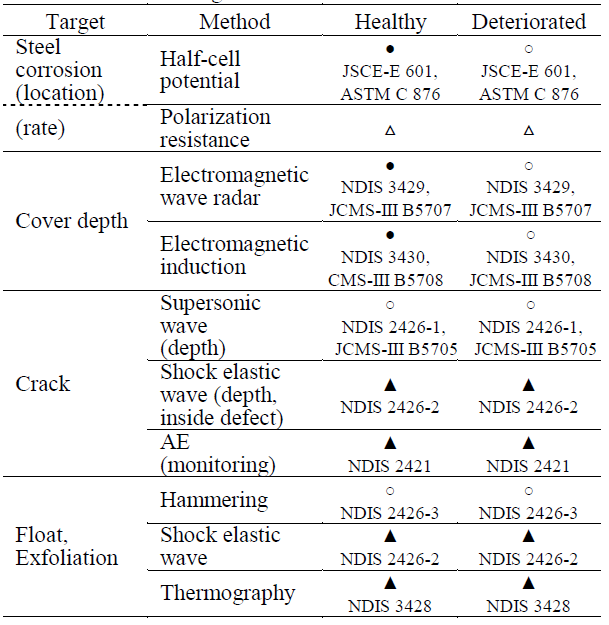
Note
●: Data by a nondestructive test connects theoretically with a physical properties value, and there are standards.
○: There are standards, but the investigation about the correspondence between data by a nondestructive test and the physical properties value is more necessary.
▲: There is much number of the applications of the nondestructive test, which is standard, but data by a nondestructive test does not connect with a physical properties value.
△: There is much number of the applications of the nondestructive test, but the standard of the test method does not exist.
4 MODELING TO ANALYZE STRUCTURAL PERFORMANCE FOR DETERIORATED MEMBER
Evaluation by structural analysis is necessary for deteriorated structures. However, for a concrete
analysis method of deterioration modeling, the input data necessary for the model, investigation methods
to obtain the necessary data, and the evaluation accuracy of every model are currently not sufficient.
Therefore, Table 3 shows a proposed approach to improve the accuracy of the modeling method of deterioration.
An approach of appropriate modeling for the necessary evaluation accuracy and the necessary
survey data will be determined. In addition, past knowledge for the corroded reinforced concrete
member was adopted in Table 3. Furthermore, the result was considered after examining the influence
of variation in materials properties and existence of the crack on the deformation property and the destruction behavior.
Table 3. Approach of modeling for nonlinear finite element analysis for deteriorated member (Example).
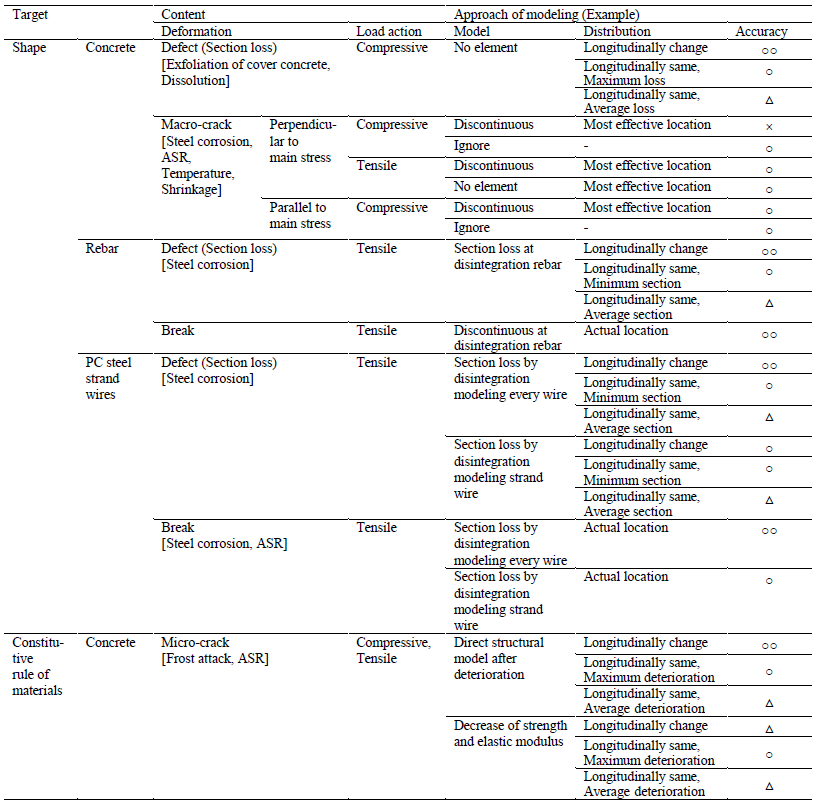
○○: The accuracy is high for an influence item, ○: Under a certain condition, accuracy is enough, △: Caution is necessary, ×: No evaluation.
Figure 2 shows the results of the structural analysis using the finite element method for the case study
target mentioned in Section 2. According to this figure, it can be confirmed that the load capacity decreases
from the 70th year. Therefore, even when repair is necessary according to the grading judgement
based on visual observation, the structural performance is the same as in the healthy state. Thus, it
can be thought that the timing of repair is delayed, and, subsequently, the repair priority decreases when
there are many deteriorated structures. However, it can be confirmed that the load capacity decreases
remarkably at the 90th year. Herein, the dead and live loads are 566 kN and 302 kN, respectively,
based on the specification for the road bridges. Therefore, it can be confirmed that the load capacity
at the ultimate state does not satisfy the required value. Thus, it can be thought that the inspections
should be strengthened if the repair was postponed at the 70th year.
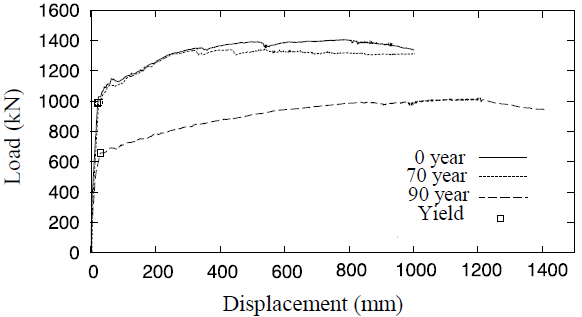
Figure 2. Relationship between load and central displacement.
5 SUMMARY
A subcommittee on “Priority in Maintenance and Management of Deteriorated Concrete Structures
(JSCE-342)” was organized from May 2010 to December 2015. This report introduces a part of final
report. Firstly, examples of the case study promoted under the flow of ideal maintenance are introduced.
Next, a method to investigate a substitution value of the performance evaluation model for the deteriorated
member on site is analyzed. Furthermore, modeling techniques to evaluate the structural performance
of the deteriorated member are analyzed while differentiating it from a model used for the design of a
healthy member. As a result, the techniques from inspection to performance evaluation were discussed
progressively. By the case study for bridges, a procedure of ideal maintenance management was also shown.
|